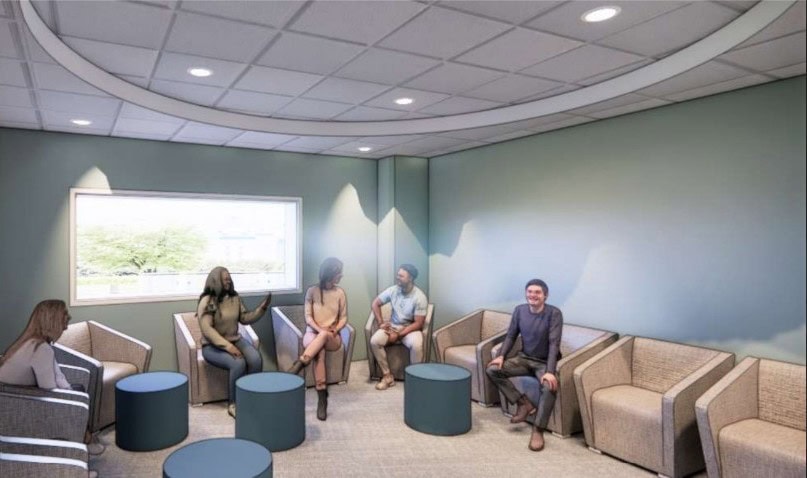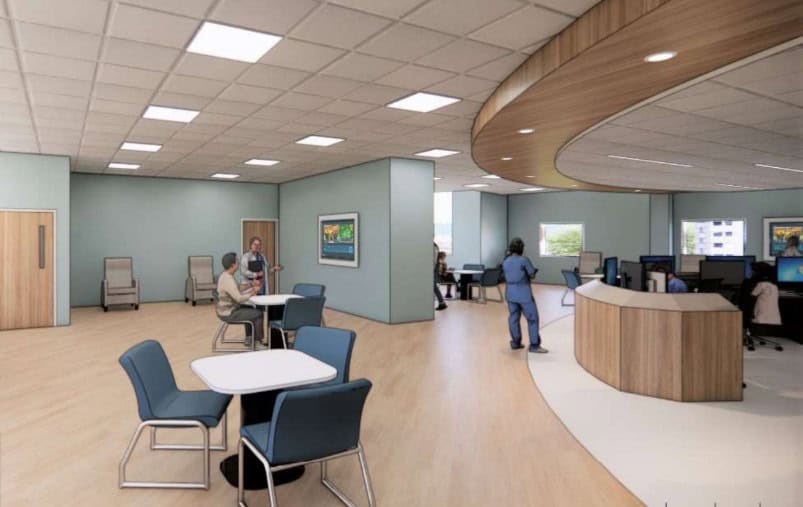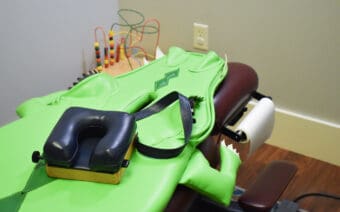
May 26, 2025
LA CROSSE – Behavioral health care is a special kind of care, Heather Schimmers, president of Emplify Health by Gundersen, said, and it deserves to be delivered in a special place.
The EmPATH unit under construction on Emplify Health by Gundersen’s La Crosse campus, she said, is a forward-thinking example of that.
EmPATH – an acronym for “emergency psychiatric assessment, treatment and healing” – Schimmers said, is an alternative way to treat patients who present in a hospital emergency room (ER) while in a mental health crisis.
Though EmPATH units exist worldwide, she said the unit being established within the behavioral health department on the hospital’s La Crosse campus is the first of its kind in Wisconsin.
There is a nationwide need for innovative solutions such as EmPATH units, Scott Zeller – vice president of acute psychiatry at Vituity, and an internationally recognized expert in emergency psychiatry – said.
Zeller said recent data shows about one-eighth of patients in U.S. emergency rooms (ERs) present because of an acute behavioral health issue, making it one of the most common reasons people go to the ER.
“That’s why it’s important to do things like EmPATH units,” he said. “I’ve been doing emergency psychiatry for more than 35 years, and I know a lot of things are possible if you immediately evaluate and start treatment for individuals with a psychiatric emergency. And, while we have outpatient clinics and inpatient facilities, what about the ‘in between?’”
Zeller said that question prompted him to pursue a San Francisco Bay-based study to substantiate what he knew from experience – that immediate evaluation and treatment, in the right therapeutic setting, delivered by the right providers, can be transformative for those in a behavioral health crisis.
The study, he said, revealed that upward of 75% of acute behavioral issues could be stabilized with an emergency level of care and discharged in fewer than 24 hours.
The takeaway, Zimmer said, was to create built-from-scratch EmPATH units, easily accessible from ERs, to treat behavioral health emergencies that fall in the space between outpatient care and inpatient hospitalization.
The outcome, he said, is more timely and compassionate care tailored to patients.
“I call (the EmPATH unit) the missing link,” he said. “It’s really important for people who might be having the worst day of their lives to have the kind of care that is targeted to them and helps them get through that really traumatic experience in a very positive and patient-centric way.”
Schimmers said Zeller shared a story with the Emplify Health by Gundersen team of why an EmPATH unit is so important by comparing a person entering the ER with labor pains to one with an acute behavioral care issue.
“For one, the ER provider confirms (the patient) is having labor pains and is going to have a baby and sends her to labor and delivery where there are experts in delivering babies,” Schimmers said. “A patient in a mental health crisis goes to the ER and shares their pains, but ERs don’t have a similar place to send patients for the type of care they need.”
Schimmers said the EmPATH unit will provide the “specialized care people need, in a special place,” serving as another treatment option in the health system’s toolbox of behavioral care options in early 2026.
“We want our people in crisis to come through the ER door and know that we are going to get them placed in the right spot for the services they need,” she said.
EmPATH to the rescue
In an EmPATH unit like the one under construction on Gundersen’s La Crosse campus, Zeller said patients with behavioral health emergencies enter the regular ER’s doors for care.
They are then assessed to confirm there are no imminent medical issues – such as ingestion of a life-threatening substance – or other emergent medical care needed before being transferred to the hospital’s nearby EmPATH unit, where they can remain for up to 23 hours to receive the care they need in a custom-tailored environment.

Having the patient’s journey begin in the ER as an entry point for care, Zeller said, makes sense – noting that ERs have become a safety net for acute behavioral health situations, with an estimated 12-15% of emergency visits being behavioral health related.
Further, he said, the ER is a natural default for patients seeking emergency-level care of any kind.
“We need patients to start there as a single door, to care,” Josh Court – clinical operations director, behavioral health for Emplify Health by Gundersen – said. “That’s the best place for them to start their journey.”
From the ER, Court said, it will be a short walk through an underground tunnel to access the EmPATH unit, away from the fast-paced, highly stimulating environment to a more suitable one.
“We recognize the ER is loud, it’s bright and people there tend to be in extreme pain,” he said. “That type of energy is not helping somebody who is suicidal or who has high, high anxiety. We need to get them out of that space and into a space in which they can heal.”
Schimmers said patients will be welcomed into a warm, open space in the EmPATH unit, assigned a recliner in that space (versus being isolated in a room) and have access to blankets from the warmer, drinks and snacks.
Big windows, she said, will bring in natural light.
Schimmers said patients then meet with behavioral health professionals to address the immediate crisis.
Other EmPATH units, Zeller said, have shown patient agitation and aggression are dramatically reduced and the need for coercive interventions, such as involuntary medications and physical restraints, drops to nearly zero in these types of environments.
“Creating a from-scratch environment with all the things I learned from my career is part of the treatment,” he said. “Having a large open space instead of feeling imprisoned or punished in a small (room), and not having to beg the staff for anything, matters. The more we focus on the environment and stick to the basic principles of rapid evaluation and immediate treatment plan, the better.”
The open space, Court said, is conducive to connection as well.
“Being connected with other humans is part of the support and healing and (is) critical,” he said.
Most patients who need the services of EmPATH, Court said, will receive what they need within 12-16 hours and then shift to continue care on an outpatient basis.
He said they leave with their acute behavioral care issue addressed in a timely manner without facing barriers of any kind to care.
Court said he knows firsthand how facing repeated barriers can thwart people’s efforts to receive the behavioral care they need.
“Over time, barriers stack and they’re less likely to get the care they need,” he said. “The beauty of EmPATH is that when people need it, it’s available to them. They don’t have to sit in an ER for hours and hours or even days on end, which we hear about happening in some other communities.”
Court said the first EmPATH unit in Wisconsin is a model he believes can be replicated in other healthcare environments.
“We believe in this model and are excited to show people how we can do this,” he said.
A top need
Schimmers said additional specialized behavioral health care is a need the community has made clear is both substantial and a priority.
The 2024 Compass Now report – a joint effort of Greater Rivers United Way, area healthcare organizations and county health departments to improve the quality of life for everyone in the community – she said, speaks to this.
The report includes the results of data collected through a community survey, focus groups, an extensive review of socioeconomic indicators and an inventory of community resources.
The most recent report showed all the counties involved (Buffalo, La Crosse, Monroe,
Trempealeau and Vernon counties in Wisconsin and Houston County in Minnesota) identified mental health as a top need, ranking No. 1 among the top five priority needs identified by community stakeholders.
The three largest themes of mental health concerns that emerged from focus groups and stakeholder meetings, according to the report, were barriers to accessing mental health care, systems issues and people struggling.
Schimmers said the report is created to provide an updated assessment of community needs that can be used to inform community action strategies by stakeholders across the region.
“The really cool thing about our region is that we make sure we are providing the care our community tells us we need to provide (by the) Compass report,” she said. “Behavioral health continues, as it does in many communities, to rise to the top. We take that report seriously in how we budget, how we strategize and how we provide our services to make sure we’re truly a community health system and serve the needs of our community.”
Forethought for future care
When the hospital’s inpatient behavioral health building was built 12 years ago, Schimmers said it left 8,000 feet unfinished with the understanding there would be a need for that space in the future.
That forethought, she said, is allowing the buildout of the EmPATH unit.
“That gave us the opportunity to do something unique and innovative,” she said. “We are able to do this because of that gift given in the planning. In health care today, 8,000 square feet of unfinished space is a hot commodity. We could have put a high-profit service line in that space, but we intentionally held it for something like this.”
Building the EmPATH unit in close proximity to other behavioral health care, Schimmers said, is a natural tie-in as well.
“It’s fast, it’s efficient and the beauty of it (being inside the behavioral health building) is that if we start in EmPATH and recognize (a patient) needs more support, it’s an easy move and transfer to one of our inpatient beds,” she said. “There is an ecosystem of intensive behavioral health services to meet patients where they are.”

In fall 2024, Schimmers said Emplify Health by Gundersen added four inpatient beds to its hospital’s behavioral care unit in response to that Compass Now report and the closures (and loss of mental health services) of HSHS and Prevea Health’s healthcare facilities in western Wisconsin.
However, Court said, it sought to do even more.
“Gundersen throughout its history has really invested in behavioral health and has a large behavioral care presence in western Wisconsin,” he said. “When those (healthcare) closures took away 40% of (behavioral health) inpatient beds on the western side of the state, we added more. But we knew there was a pocket of patients who we could serve better through the EmPATH model.”
Court said embracing the EmPATH model makes sense to fill the gap of patients who need more follow-up than every week or every other week with an outpatient therapist but also don’t need multiple days in an inpatient behavioral health unit.
“We did our research on models out there of how we could fill that gap and be the most effective and efficient for those patients,” he said. “After we talked to Dr. Zeller and learned how it works, we felt like this would be an important piece of our behavioral health puzzle, a fit between outpatient care and multiple-day inpatient days that will allow us to serve even more patients.”
Schimmers said the goal at Emplify Health by Gundersen is to create a healthier, more resilient community.
“That means you don’t ignore behavioral health but make it a priority,” she said. “The people in our communities understand they won’t struggle alone – we will walk with them on their journey.”
Community, team rally behind EmPATH
Court said the community’s response to the forthcoming EmPATH unit has been astounding.
“People just light up because this is such a community need and yet such a simple (solution),” he said. “They get it. So many people talk about a friend, a family member or other person who they wish had had (an EmPATH unit) available to them at a time in their life.”
Schimmers said behavioral health issues aren’t confined to a particular demographic.
“Mental health doesn’t discriminate – it presents in different ways, different venues and in different demographics,” she said.
The World Health Organization has reported that COVID-19 triggered a 25% increase in the prevalence of anxiety and depression worldwide.
Schimmers said she believes that some of the increased healthcare utilization can be attributed to that and believes more people are facing the stigma and seeking the services they need.
“I think they’re getting more comfortable addressing it, talking about it and seeking out care and treatment to have a productive life,” she said. “In particular, the comfort level our young people have in talking about their mental health needs and how they seek treatment is different than in the past. That is awesome for those of us who care about treating the whole person – health care is about taking care of the brain as much as it is about taking care of everything else.”
Those efforts, Schimmers said, started with recognizing the need, prioritizing it and the Gundersen Medical Foundation stepping in to help.
“We have some incredible partners in the foundation, as well as the community, I can’t begin to even tell you,” she said. “We haven’t really gone out and asked for support beyond the roadshow Josh has been doing, telling stories. The support is so humbling and overwhelming, with the community stepping up in a way that I have great hope will pay for (the EmPATH unit) by our community.”
The forthcoming EmPATH unit, Schimmers said, is resonating not only with the community at large but behavioral care providers as well.
When touring the unit under construction, she said a behavioral health nurse who has worked for the hospital for 40 years approached her to thank her for making the EmPATH unit a priority, not only for the patients but for providers who want to provide cutting-edge care.
“She thanked me for allowing her to practice clinically where her heart is and offering the opportunity to have a full career here,” she said. “That is just one story among our team, and Josh’s retention in that unit is fabulous.”
Clinical recruitment and retention, Schimmers said, is understandably top of mind in a world in which health provider recruitment weighs heavily on people’s minds.
Emplify Health by Gundersen, she said, has found great success because it appeals to clinicians who want to provide fully integrated behavioral health care, while simultaneously offering next steps for their growth as well.
It’s an area that Court said they always monitor but have created a culture in which team members see Emplify by Gundersen’s investment in behavioral health and the thoughtfulness, energy and time that goes into their integrated approach to behavioral care.
“Things like our EmPATH unit show that Gundersen puts its money where its mouth is,” Court said. “Staff want to be a part of something like that.”
Zeller said the resounding success of the EmPATH model has led to the launch of more than 60 locations – including ones in Singapore, Canada, Mexico and Australia, with additional locations under consideration in Scotland and England – producing results for all types of hospitals and patient populations.He said they’re on track to have more than 10 additional EmPATH units in the U.S. by 2027, including the launch of the La Crosse EmPATH unit in early 2026.
“I’m very positive they will be successful as there are true leaders in Josh and Heather who are making sure the community knows about it,” he said. “When you have believers who understand what a difference it can make, we see success. I’m very impressed with the people at Gundersen, and I’m confident they’re going to knock it out of the park.”
 A place for pancakes, people – The Pancake Place earns state recognition
A place for pancakes, people – The Pancake Place earns state recognition Green Bay Public Market expected to fall short of 2025 NFL Draft deadline
Green Bay Public Market expected to fall short of 2025 NFL Draft deadline







